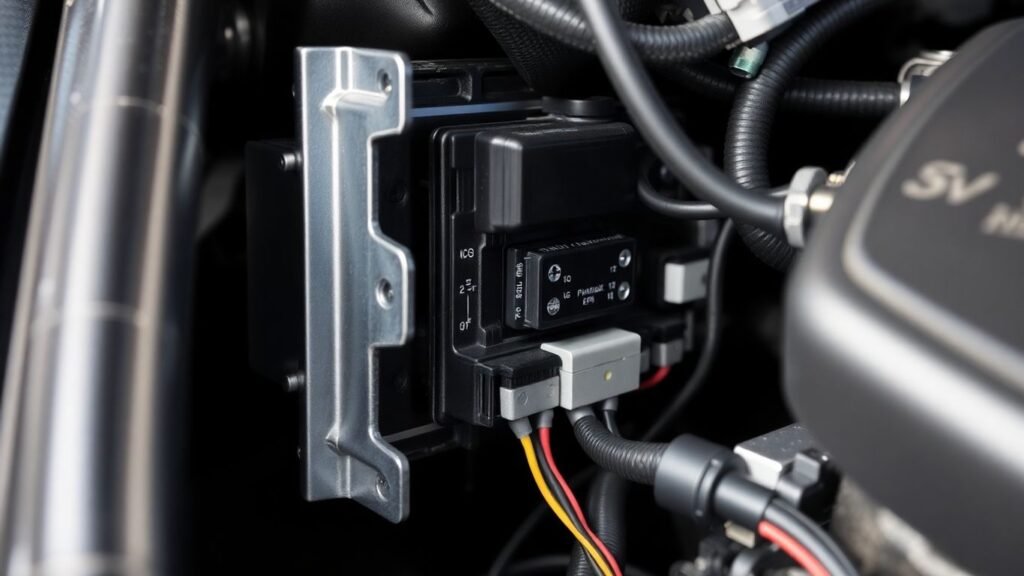So, your Mazda’s acting up, and you’re wondering if it’s the brain of the operation – the Mazda ECU module? It happens. These little computer brains control a lot, and when they get wonky, your car can do some pretty strange things. This guide is here to help you figure out if your Mazda ECU module is the culprit and what you can do about it, without making things more complicated than they need to be.
Key Takeaways
- When your Mazda ECU module has problems, you might see a check engine light that won’t go away, or your car might stall or have trouble starting.
- Common issues with the Mazda ECU module can lead to a rough idle, loss of power, or your car drinking more gas than usual.
- Before you blame the Mazda ECU module, check other parts like the ignition system, fuel delivery, sensors, and wiring. Sometimes the fix is simpler.
- Resetting your Mazda ECU module involves disconnecting the battery and a few other steps, followed by a specific way of driving to help it relearn.
- Taking care of your Mazda by sticking to maintenance, using good fuel, and fixing problems fast can help keep your Mazda ECU module working right for a long time.
Diagnosing Mazda ECU Module Issues With Trouble Codes

Understanding Mazda Diagnostic Trouble Codes
So, your check engine light is on, and you’re wondering what’s going on under the hood. That little light is usually your Mazda’s way of telling you something’s up, and it’s often linked to the ECU, or Engine Control Unit. Think of the ECU as the car’s brain. When it detects a problem, it spits out a code. These are called Diagnostic Trouble Codes, or DTCs. They’re basically a secret language the car uses to tell us what’s wrong. Learning to read these codes is your first big step in figuring out what needs attention. Without them, you’re just guessing, and that can get expensive fast.
Common Mazda Trouble Codes and Their Meanings
There are a ton of these codes out there, but some pop up more often than others. For instance, codes starting with ‘P0’ usually relate to the powertrain, like the engine and transmission. You might see things like P0300, which means there’s a random engine misfire. Or maybe P0171, indicating the engine is running too lean, meaning not enough fuel is getting mixed with the air. Then there are codes like P0420, which often points to an issue with the catalytic converter. It’s helpful to have a list handy, but remember, a code tells you what the car thinks is wrong, not necessarily why.
| Trouble Code | Description |
|---|---|
| P0300 | Random/Multiple Cylinder Misfire Detected |
| P0171 | System Too Lean (Bank 1) |
| P0420 | Catalyst System Efficiency Below Threshold (Bank 1) |
| P0603 | Internal Control Module KAM Error |
| P0442 | EVAP System Leak Detected (Small Leak) |
How to Read Mazda ECU Module Trouble Codes
To actually get these codes out of your car, you’ll need a tool called an OBD-II scanner. You can buy one yourself, or many auto parts stores will read them for free. The OBD-II port is usually tucked away under the dashboard on the driver’s side. Once you plug the scanner in, you’ll turn your car’s ignition to the ‘on’ position (but don’t start the engine). Then, just follow the scanner’s instructions to pull the codes. It’ll display a series of letters and numbers, like the ones we talked about. Write them down, and then you can look up what they mean. It’s pretty straightforward once you have the scanner hooked up.
Sometimes, a simple fix like tightening your gas cap can clear a code related to the evaporative emission system. It’s always worth checking the easy stuff first before you start replacing parts.
Recognizing Signs of a Failing Mazda ECU Module
Sometimes, your Mazda’s computer, the ECU, starts acting up. It’s not always a sudden breakdown; often, it’s a slow creep of weird issues that can leave you scratching your head. Paying attention to these subtle (and not-so-subtle) symptoms is your first line of defense against a full-blown ECU failure.
Persistent Check Engine Light After Reset
You know that little check engine light? It’s usually a good indicator that something’s up. But if you’ve had it cleared, maybe after a minor fix, and it just keeps coming back on, that’s a red flag. It suggests the problem isn’t a simple one-off glitch but something more persistent, possibly pointing to the ECU itself struggling to manage a system correctly. It’s like telling your computer to ignore a problem; eventually, it’ll just keep reminding you.
Intermittent Engine Shut-Offs and Starting Problems
This is a really unnerving one. If your engine suddenly dies while you’re driving, or if the car cranks but just won’t start sometimes, it could be the ECU. The ECU controls so many critical functions, like fuel injection and ignition timing. When it starts to falter, it can cut power unexpectedly or fail to send the right signals to get the engine going. It might happen when the engine is hot, or just randomly. It’s not always the battery or the starter; sometimes, the brain is the issue.
Physical Damage or Connector Issues on the Mazda ECU Module
This one’s a bit more straightforward. If you’ve had the ECU module out, or if you’re looking under the hood, check for any obvious signs of trouble. We’re talking about cracked casings, burn marks, or corrosion on the connectors. Sometimes, water can get into the ECU housing, or it might overheat internally. Also, check the wiring harness that plugs into the ECU. Loose, corroded, or damaged pins in the connector can cause all sorts of communication problems between the ECU and the rest of the car’s systems. It’s like having a bad phone connection – the message just doesn’t get through right.
Sometimes, the ECU can fail due to external factors like a bad jump-start with reversed polarity, or even damage from a fire or flood. These aren’t internal component failures but rather external events that compromise the module’s integrity. Always be careful when jump-starting and be aware of your car’s environment.
| Symptom Category | Specific Issues |
|---|---|
| Electrical | Check engine light stays on after reset, Loss of communication with diagnostic scanner |
| Engine Operation | Engine shuts off unexpectedly, Intermittent starting problems, Erratic idle, Engine stalling |
| Physical | Water or fire damage visible on ECU, Broken or damaged connector pins |
| Internal | ECU overheating, Checksum or memory errors |
Common Mazda ECU Module Performance Problems

Sometimes, your Mazda’s engine just doesn’t feel right, and it’s not always obvious why. When the Engine Control Unit (ECU) starts acting up, it can cause a whole host of weird issues that make driving less than enjoyable. These problems can range from subtle annoyances to serious drivability concerns.
Erratic Idle and Engine Stalling
One of the first things you might notice is that your engine’s idle speed isn’t steady. It might hunt up and down, or the engine could even cut out completely, especially when you’re stopped at a light or in traffic. This often happens because the ECU isn’t correctly managing the air-fuel mixture or the idle air control valve. It’s like the car can’t make up its mind how much gas and air it needs to keep running smoothly at low speeds.
Reduced Power and Poor Running Conditions
If your Mazda feels sluggish, like it’s lost its pep, the ECU could be the culprit. You might experience hesitation when you press the accelerator, or the engine might just feel generally weak. This can be due to the ECU sending incorrect signals to the fuel injectors or ignition system, meaning the engine isn’t getting the right amount of spark or fuel at the right time. It’s a frustrating feeling when your car doesn’t respond like it used to.
Increased Fuel Consumption and Misfires
An ECU that’s not functioning properly can also lead to your car guzzling more gas than usual. If the fuel injectors are over-fueling the engine, or if the timing is off, you’ll see that fuel gauge drop faster. On top of that, you might start experiencing engine misfires. You could feel a shudder or a rough patch in the engine’s power delivery, and sometimes you might even hear a popping sound. This usually means one or more cylinders aren’t firing correctly, often because the ECU isn’t telling them to at the right moment or with the right intensity.
When the ECU isn’t working right, it’s like the brain of your car is getting confused. It can’t properly tell all the other parts what to do, leading to a cascade of problems that affect how the engine runs, how much fuel it uses, and even how smoothly it idles. It’s important to pay attention to these signs because they can point to a more significant issue with the ECU itself.
| Symptom | Potential ECU Cause |
|---|---|
| Unstable or fluctuating idle | Incorrect idle air control signal, fuel mixture issues |
| Engine stalling | Poor fuel delivery management, ignition timing errors |
| Hesitation on acceleration | Delayed or incorrect fuel injector pulse |
| Reduced engine power | Suboptimal ignition timing, lean/rich fuel mixture |
| Poor fuel economy | Over-fueling, inefficient combustion |
| Engine misfires | Incorrect spark timing, faulty injector signals |
Troubleshooting Related Components Before Mazda ECU Module Replacement
Before you go and spend a bunch of money on a new ECU for your Mazda, it’s a really good idea to check out some of the other parts that talk to it. Sometimes, the problem isn’t the ECU itself, but something else that’s making the ECU act weird. It’s like blaming the messenger when the message is messed up, you know?
Ignition System Components
Your ignition system is super important for getting the engine to fire up. Things like spark plugs, ignition coils, and even the ignition module can go bad. If these aren’t working right, the ECU might be getting bad signals or not getting the right signals at all, leading to misfires or a no-start situation. It’s worth checking these out first. A faulty ignition coil, for example, can cause a P0300 code (random misfires), which might make you think the ECU is toast, but it’s often just the coil.
Fuel Delivery System Checks
Next up, let’s talk about fuel. The ECU controls how much fuel gets into the engine, but it relies on other parts to do its job. The fuel pump needs to deliver the right pressure, and the fuel injectors need to spray fuel correctly. If the fuel pump is weak or an injector is clogged, the engine won’t run right, and the ECU might be trying to compensate for something it can’t fix. A P0171 code (system too lean) could be a sign of a fuel delivery problem, not necessarily an ECU issue.
Sensor Malfunctions Affecting the Mazda ECU Module
Your Mazda has a bunch of sensors all over the place, and they’re constantly feeding information back to the ECU. Think about the Mass Air Flow (MAF) sensor, the Throttle Position Sensor (TPS), or even the crankshaft and camshaft position sensors. If any of these sensors start giving faulty readings – maybe they’re dirty, damaged, or just worn out – the ECU will get bad data. This can lead to all sorts of problems, from rough idling to poor acceleration. For instance, a dirty MAF sensor can cause hesitation and poor performance, making you think the ECU is the culprit.
Wiring Harness and Relay Integrity
Don’t forget about the wires and relays! The wiring harness is like the nervous system of your car, connecting everything. Loose connections, frayed wires, or corroded grounds can cause all sorts of intermittent and confusing problems. The ECU needs a solid connection to work properly. Relays are basically electronic switches that control power to different systems, like the fuel pump. If a relay is stuck or not making good contact, the ECU might not be able to activate a critical component. Checking fuses and relays is a quick and easy step that can save you a lot of headaches.
It’s easy to jump to conclusions and think the ECU is the problem, especially when the check engine light comes on. But honestly, most of the time, the issue lies with a less expensive and easier-to-replace component that’s sending bad information to the ECU. Always start with the basics before considering a full ECU replacement.
Here’s a quick look at some common culprits:
| Component | Potential Issue | Symptom | Related Codes |
|---|---|---|---|
| Crankshaft/Camshaft Sensor | Failure or dirty connection | No start, rough running | P0335, P0340 |
| MAF Sensor | Dirty or faulty | Poor acceleration, stalling | P0101, P0102 |
| TPS | Worn or damaged | Erratic throttle response | P0120, P0122 |
| Fuel Pump Relay | Stuck or faulty | No fuel delivery, no start | N/A |
| Ignition Coil | Weak or failed | Misfires, rough idle | P0300-P0308 |
Resetting and Relearning Procedures for Your Mazda ECU Module
Sometimes, after dealing with some electronic gremlins or even after certain repairs, you might need to give your Mazda’s ECU a fresh start. This isn’t usually a complicated process, but it does require a bit of patience. Think of it like rebooting a computer when it gets sluggish – you’re clearing out temporary data and letting it start fresh.
Performing a Basic ECU Reset
A common way to reset the ECU involves a simple battery disconnect. First, you’ll want to disconnect the negative terminal from your car battery. After that, get inside the car. Turn on the headlights, then turn them off. Give the horn a quick honk. Then, press and release the brake pedal about five times. It’s a good idea to leave the battery disconnected for at least 10 to 15 minutes to make sure everything clears out properly. Once you reconnect the negative terminal, start the car and let it idle for a few minutes. This allows the ECU to start relearning basic engine parameters.
Resetting NVRAM and KAM Memory
Beyond a simple reset, there are specific procedures for clearing out different types of memory within the ECU. NVRAM (Non-Volatile Random Access Memory) and KAM (Keep-Alive Memory) store different kinds of data. KAM, for instance, holds sensor data and learned engine adjustments. To reset the main PCM, excluding KAM, you can try this: with the key off, hold down the odometer reset button and turn the key to the ‘on’ position. Keep holding the button until "TEST" appears on the odometer, then release it. Turn the key off and repeat this step. This clears most of the PCM’s learned data.
To reset the KAM specifically, with the key in the ‘on’ position, rapidly press the brake pedal about 20 times. You might notice the oil pressure gauge sweep back and forth as you do this. This action targets the KAM memory, which stores things like sensor profiles.
It’s important to note that these resets won’t erase your radio presets, so you won’t have to re-tune all your favorite stations.
Post-Reset Engine Relearning Process
After you’ve performed a reset, the ECU needs to relearn how your specific engine operates. This is where driving style comes into play. For the first 30 minutes or so after the reset and reconnection, drive gently. Avoid hard acceleration or sudden braking. This helps the ECU learn optimal fuel efficiency and smooth operation. If you were to immediately drive aggressively, the ECU might learn that high fuel delivery is the norm, which isn’t usually what you want for everyday driving.
| Memory Type | Reset Procedure Focus | Typical Data Retained |
|---|---|---|
| NVRAM | PCM Reset (excluding KAM) | Most learned engine parameters |
| KAM | Specific KAM Reset | Sensor profiles, adaptive settings |
Preventative Care for Your Mazda ECU Module
Adhering to Regular Maintenance Schedules
Keeping up with your Mazda’s scheduled maintenance is more than just oil changes and tire rotations; it’s a key part of protecting your ECU. When you follow the manufacturer’s recommended service intervals, you’re helping to prevent issues that could indirectly affect the ECU. For instance, ensuring your cooling system is in good shape prevents overheating, which can stress electronic components. Likewise, keeping the electrical system healthy means the alternator isn’t overworking, which can prevent voltage spikes that might damage the ECU. Think of regular maintenance as a shield for your car’s brain.
Using Quality Fuel and Fluids
The type of fuel and fluids you use can have a surprising impact on your ECU. Using low-quality fuel can lead to deposits in the engine that disrupt combustion, causing the ECU to work harder to compensate. This constant adjustment can put a strain on its processors over time. Similarly, using the wrong type of oil or coolant can lead to poor lubrication or overheating, both of which can cause problems that the ECU has to manage. Always stick to the specifications listed in your owner’s manual for fuel octane ratings and fluid types. It’s a simple step that pays off in the long run.
Promptly Addressing Warning Lights
That little check engine light isn’t just for show. When it illuminates, it’s the ECU telling you something is wrong. Ignoring it is like ignoring a doctor’s advice – it usually leads to bigger problems down the road. Sometimes, a warning light might be triggered by a minor sensor issue, but it could also be an early sign of something more serious. Don’t wait for the problem to get worse. Getting it checked out quickly, perhaps with an OBD-II scanner to read the trouble codes, can help you catch issues before they escalate and potentially cause damage to the ECU itself or other vital components.
The ECU is designed to manage a lot of complex systems. When one part of the system starts to falter, the ECU tries its best to compensate. However, if these issues aren’t addressed, the ECU can be put under undue stress, potentially leading to its own failure. Regular checks and prompt repairs are the best way to keep everything running smoothly.
Wrapping It Up
So, dealing with your Mazda’s ECU might seem a bit much at first, but hopefully, this guide has made it less scary. We’ve gone over some common problems, how to spot them using those tricky codes, and even a few ways you might be able to fix them yourself, like resetting the ECU. Remember, though, if you’re not comfortable or the issue is serious, getting a pro to look at it is always the smart move. Keeping up with regular maintenance and not ignoring warning lights will go a long way in keeping your Mazda running smoothly for years to come. Happy driving!








